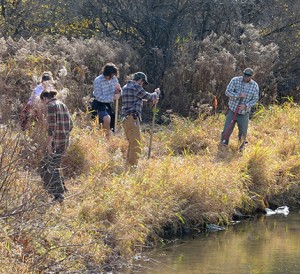Plant a Tree (or Two) for Lake Champlain
by Executive Director Chris Boget
Did you know that the simple act of planting a tree (or two) in your yard can help protect the water quality of Lake Champlain? In addition to growing into a beautiful shade-producing, energy-saving feature of your yard, planting a tree is a positive step you can take to protect the water quality of our local waterways.
Everyone is talking about water quality, and many are asking: What can I do to help protect water quality in my community? A great first step is to reduce the amount of water flowing off your property during rainstorms. Even within the relatively flat Champlain Valley, most properties have slopes and contours that can easily erode given the increasing severity of recent storms. Rainfall running across an exposed patch of soil or even along the edge of a driveway can quickly wash sediments and phosphorous into local streams.
Have you ever seen a washed out gully in a natural forest? It’s not likely, because trees reduce the force of heavy rains—the canopy of leaves change stinging rains into drips and the forest floor soaks up the rain. Just like in a forest setting, you can retire that problematic wet patch of lawn by planting a tree to help deflect and absorb water. Add mulch or allow its leaves to form a natural mulch that absorbs rainfall better than lawns. Not only does the decomposing layer of leaves soak up rainfall like a natural sponge, it can capture water flowing by from outside the tree’s canopy.
Tree roots are another great natural sponge. Planting trees along the low point or the downstream edge on your property immediately brings a large network of underground roots eager to soak up available water. It has been estimated that a mature maple tree can absorb up to 10,000 gallons of water per season. Planting trees near eroding banks or ditches allows the tree roots to hold the surrounding soils in place, preventing them from washing downstream in the next storm.
Vermonters are eager to protect our local waterways from the negative impacts of phosphorous, pollutants, and sediments flowing from our properties down into Lake Champlain. Limiting the runoff from everyone’s yard would help reduce the amount of phosphorous and pollutants washing into stormwater systems that often direct water straight into local waterways feeding Lake Champlain.
People ask us all the time which tree to plant, and it is hard to select the right species without seeing the location. The native Red Maple (Acer rubrum) is a great choice for most properties as they do well in both wet and dry conditions.
Planting a tree may seem like a small step, but from the moment you place one in the soil it starts protecting the Lake. Over time, as the canopy grows, roots spread, and leaf litter collects, its water quality impact only increases.
If you are interested in learning more about what trees to plant, please contact us at .

